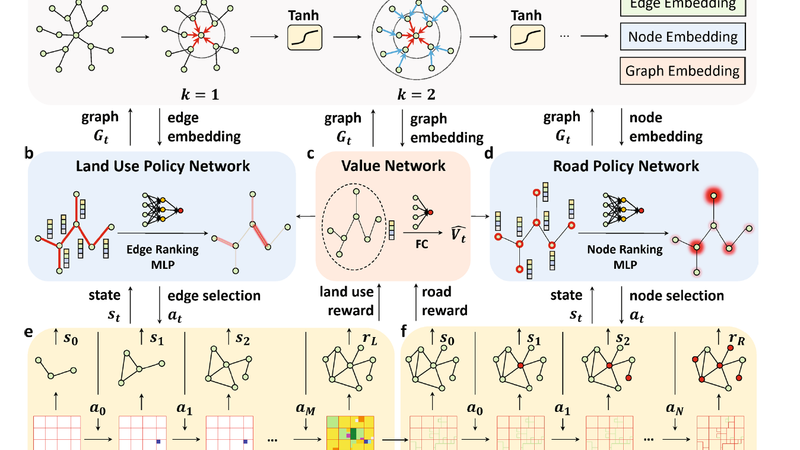From Pixels to Pavement: AI's Impact on Urban Design
Researchers have harnessed the power of Artificial Intelligence (AI) to optimize community layouts, making cities more efficient, accessible, and sustainable

The framework which consists of two separate policy networks (b and d) that take actions for the land use planning task (e) and road planning task (f) respectively, and share a GNN state encoder (a) with a value network (c) that estimates the effect of the current planning result.
This article was discussed in our Next Byte podcast.
The full article will continue below.
Why You'll Love This Article
Urban planning, the art of designing and shaping the cities we live in, is undergoing a quiet revolution. Researchers have harnessed the power of Artificial Intelligence (AI) to optimize community layouts, making cities more efficient, accessible, and sustainable. In this article, we'll delve into the world of AI-driven urban planning, exploring the challenges it addresses, the ingenious solution it offers, and the tangible impact it promises.
This research was conducted by researchers at Tsinghua University, Beijing and the full article can be found on Nature.
The Woes of Urban Development
Cities are intricate puzzles with myriad pieces: roads, buildings, parks, and services. Urban planners face the daunting task of piecing together these elements to create functional and harmonious communities. Traditionally, this process relied on manual labor and heuristics, often resulting in suboptimal designs and lengthy planning cycles.
One of the fundamental challenges in urban planning is optimizing the spatial layout. How can we ensure that essential services like schools and hospitals are easily accessible to residents? How do we strike the right balance between green spaces and built-up areas? And how can we design road networks that are efficient and free from congestion?
What's The Solution?
The researchers behind this groundbreaking approach have devised a solution that takes urban planning to new heights. At its core is an AI agent trained to make informed decisions about community layouts. But training an AI to plan cities is no small feat. It involves running millions of simulations, a process akin to trial and error, where the AI learns from its mistakes and successes.
Central to this solution is a tool called a Graph Neural Network (GNN). Think of it as a virtual brain capable of comprehending and processing geographical data. It constructs a graph to represent the urban environment, where nodes symbolize various urban elements, and edges capture their relationships and contiguity.
Why opt for a GNN, you may wonder? Urban planning is complex, with countless interconnections between different elements. Traditional methods often struggle to consider these intricate relationships. Enter the GNN, with its ability to analyze these connections, making it a crucial asset. It examines city layouts, understands the interactions between different components, and uses this knowledge to make informed decisions.
But Does It Actually Work?
Now, let's talk about the real-world impact. This AI-powered approach isn't just theoretical; it's a game-changer for urban planning.
Efficiency Boost
The AI agent can generate spatial plans in milliseconds, a stark contrast to the hours or days traditional methods require. This significant time saving can expedite the planning process.
Service Accessibility
The AI excels at optimizing community services. It ensures that essential services like schools and hospitals are within a short walking or cycling distance for residents. The accessibility metric indicates a remarkable improvement compared to conventional planning methods.
Ecological Enhancements
The AI knows how to make communities greener. It excels at covering residential areas with greenery, improving the quality of life and environmental sustainability.
Traffic Efficiency
The AI is a traffic virtuoso too. It ensures roads are dense, well-connected, and appropriately spaced, leading to smoother traffic flow and reduced congestion.
By combining these quantitative results, the impact becomes clear. AI-driven urban planning promises substantial time savings, enhanced accessibility to services, greener environments, and efficient traffic networks. It's a recipe for creating smarter and more livable cities.
What Are The Limitations?
It's vital to recognize that the success of this AI system hinges on the quality of input data. Inaccurate or incomplete geographical information can hamper its performance and while AI is a potent tool, it's not a replacement for human planners; In fact, it should work alongside human experts, balancing technological prowess with human creativity and judgment.
TL;DR (Too Lazy; Didn't Read)
AI-driven urban planning marks a significant leap forward in the quest to create better cities. It harnesses the power of AI and GNNs to optimize spatial layouts, making cities more efficient, accessible, and sustainable. While challenges and limitations remain, the potential for smarter, more livable cities is within reach, thanks to the fusion of artificial and human intelligence.
